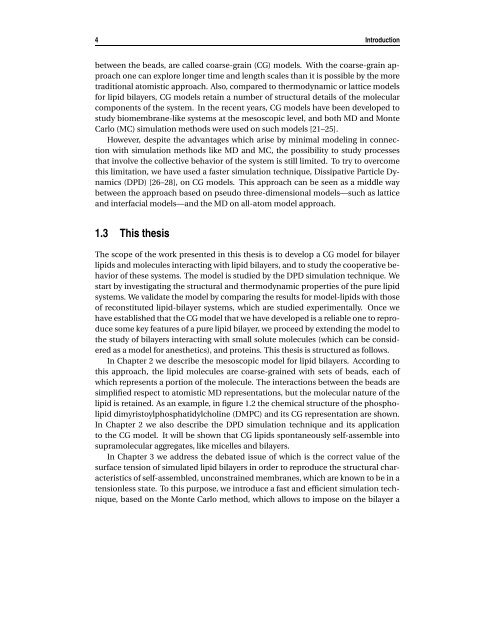Mesoscopic models of lipid bilayers and bilayers with embedded ...
Mesoscopic models of lipid bilayers and bilayers with embedded ...
Mesoscopic models of lipid bilayers and bilayers with embedded ...
Create successful ePaper yourself
Turn your PDF publications into a flip-book with our unique Google optimized e-Paper software.
4 Introduction<br />
between the beads, are called coarse-grain (CG) <strong>models</strong>. With the coarse-grain approach<br />
one can explore longer time <strong>and</strong> length scales than it is possible by the more<br />
traditional atomistic approach. Also, compared to thermodynamic or lattice <strong>models</strong><br />
for <strong>lipid</strong> <strong>bilayers</strong>, CG <strong>models</strong> retain a number <strong>of</strong> structural details <strong>of</strong> the molecular<br />
components <strong>of</strong> the system. In the recent years, CG <strong>models</strong> have been developed to<br />
study biomembrane-like systems at the mesoscopic level, <strong>and</strong> both MD <strong>and</strong> Monte<br />
Carlo (MC) simulation methods were used on such <strong>models</strong> [21–25].<br />
However, despite the advantages which arise by minimal modeling in connection<br />
<strong>with</strong> simulation methods like MD <strong>and</strong> MC, the possibility to study processes<br />
that involve the collective behavior <strong>of</strong> the system is still limited. To try to overcome<br />
this limitation, we have used a faster simulation technique, Dissipative Particle Dynamics<br />
(DPD) [26–28], on CG <strong>models</strong>. This approach can be seen as a middle way<br />
between the approach based on pseudo three-dimensional <strong>models</strong>—such as lattice<br />
<strong>and</strong> interfacial <strong>models</strong>—<strong>and</strong> the MD on all-atom model approach.<br />
1.3 This thesis<br />
The scope <strong>of</strong> the work presented in this thesis is to develop a CG model for bilayer<br />
<strong>lipid</strong>s <strong>and</strong> molecules interacting <strong>with</strong> <strong>lipid</strong> <strong>bilayers</strong>, <strong>and</strong> to study the cooperative behavior<br />
<strong>of</strong> these systems. The model is studied by the DPD simulation technique. We<br />
start by investigating the structural <strong>and</strong> thermodynamic properties <strong>of</strong> the pure <strong>lipid</strong><br />
systems. We validate the model by comparing the results for model-<strong>lipid</strong>s <strong>with</strong> those<br />
<strong>of</strong> reconstituted <strong>lipid</strong>-bilayer systems, which are studied experimentally. Once we<br />
have established that the CG model that we have developed is a reliable one to reproduce<br />
some key features <strong>of</strong> a pure <strong>lipid</strong> bilayer, we proceed by extending the model to<br />
the study <strong>of</strong> <strong>bilayers</strong> interacting <strong>with</strong> small solute molecules (which can be considered<br />
as a model for anesthetics), <strong>and</strong> proteins. This thesis is structured as follows.<br />
In Chapter 2 we describe the mesoscopic model for <strong>lipid</strong> <strong>bilayers</strong>. According to<br />
this approach, the <strong>lipid</strong> molecules are coarse-grained <strong>with</strong> sets <strong>of</strong> beads, each <strong>of</strong><br />
which represents a portion <strong>of</strong> the molecule. The interactions between the beads are<br />
simplified respect to atomistic MD representations, but the molecular nature <strong>of</strong> the<br />
<strong>lipid</strong> is retained. As an example, in figure 1.2 the chemical structure <strong>of</strong> the phospho<strong>lipid</strong><br />
dimyristoylphosphatidylcholine (DMPC) <strong>and</strong> its CG representation are shown.<br />
In Chapter 2 we also describe the DPD simulation technique <strong>and</strong> its application<br />
to the CG model. It will be shown that CG <strong>lipid</strong>s spontaneously self-assemble into<br />
supramolecular aggregates, like micelles <strong>and</strong> <strong>bilayers</strong>.<br />
In Chapter 3 we address the debated issue <strong>of</strong> which is the correct value <strong>of</strong> the<br />
surface tension <strong>of</strong> simulated <strong>lipid</strong> <strong>bilayers</strong> in order to reproduce the structural characteristics<br />
<strong>of</strong> self-assembled, unconstrained membranes, which are known to be in a<br />
tensionless state. To this purpose, we introduce a fast <strong>and</strong> efficient simulation technique,<br />
based on the Monte Carlo method, which allows to impose on the bilayer a

















